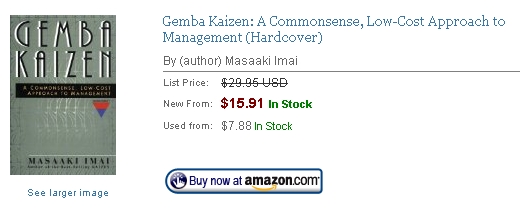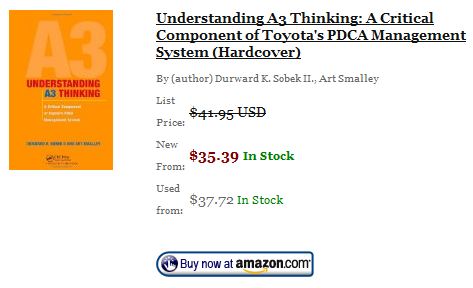In a recent thread on the Toyota Alumni page on Linkedin (you must be an Alumni of Toyota to join and read the thread), there was a question on whether Toyota practices the principles of The Toyota Production System (Lean) in the Office. Below are some of the answers, many of which are quite interesting.
Lean Office
Answer from Raul Gabriel Ramos (Alumni, Toyota San Antonio Texas):
In my experience, not only did I see the Toyota Production System (TPS) manufacturing principles permeating the production floor but also the office setting. Although there are many lean “tools” we can apply to the “Genba” or “workplace” because of TPS, the main power sustaining it is having a culture based on continuous improvement. This aside, some key examples I noticed were the following:
Productivity
One example I recall to increase productivity if confronted with repetitive tasks, such as data entry in MS Excel, was to use macros or Visual Basic for Applications (VBA) to program Excel to automatically handle such tasks at a more efficient pace.
Another reason why this is useful is because mistakes do happen due to inevitable human error. So when handling repetitive tasks manually, sometimes we expose ourselves to making mistakes therefore by using automated processes we can create a “Pokayoke” or “Error-proof” system.
Continuous Flow Processing
This is the reduction of inventory between processes to a minimum and producing one piece at one time. Although when we think of “flow”, we typically think of raw material or a car body flowing from department to department, but this can also apply to paperwork.
As an example, imagine you must complete some paperwork and then it must be submitted to a different department for review but you find out that this paperwork “waits” for several days before it is processed. This can be viewed as “Muda” or waste, which is of Inventory (work in-process) and Overproduction (producing earlier than needed).
By applying one of the pillars of TPS, Just-In-Time (right part, in the right amount, to the right place and at the right time), wisdom to improve the process “Kaizen” and sharing the knowledge with those involved “Yokoten”, you’ll be on your way to getting closer to a more continuous flow, but there is always room for improvement.
5S
By applying 5S to our work area, such as our desks and files, we can ensure an increase in productivity and elimination of additional waste. We can accomplish this by ensuring only necessary items are kept, that everything that is necessary has a place and everything is in its place, cleaning our area, monitoring the 1st 3S and sustaining it all. The hardest S of all 5 is the last – “Sustain.”
Imagine having to sift through a disorganized filing cabinet and having to look for a specific piece of paper in order to continue your work. This will more than likely cause a decrease in productivity.
Standardized Work
By adopting successful and stable processes, you can create efficient sequences without any waste or “muda.” Here is an example. Say you and a fellow colleague alternate back and forth with having to complete a report. You will be responsible for completing this report one given week and then your colleague will be responsible for completing it the following week. But you each go about it in different ways. It takes you 30 minutes to complete while your colleague takes 1 hour and a half to do the same job. The most efficient “working sequence” is yours so you “standardize” that process and teach it to your colleague to maintain efficiency and consistency throughout.
These are a few basic examples I can think of. I hope this helps.
Answer from Jon Lovelock (Toyota Alumni, Derby United Kingdom):
Having worked at the Burnaston plant for 13 years, Toyota does not practice lean in the offices or on the manufacturing floor. Lean is a terminology generated to provide a commercial offering to the outside world. In my first week at the plant, during my induction, it was explained to me that they operated a lean manning system, ie there isn’t many people. The office sector was rarely used from my perspective, as a production leader my role was to deal with it, quickly, simply and stop it happening. the office tended to work as any other office environment albeit using the same lean manning ethos, they just worked overtime a lot to get the job done.
Incidently 5S did not exist at Toyota, it was 4S. the fifth is again a way of telling the outside world to sustain it. At Toyota it was normal business. The 4S’s are Seiri, Seiton, Seiso and Seiketsu.
Another point to note. The beleif that Muda is the only focus in Toyota is also misunderstood. The focus is on Muda, Muri and Mura. theses are waste, overburden and uneveness (Heijunka).
Answer from Jack Bloodworth (Toyota Alumni, National Manager for Toyota Real Estate):
From the real estate and facilies side the answer is Yes! When new offices and facilities were considered we listened to and asked questions of the business unit to assure we understood their needs and created workspace with the most efficient work flow possible. Examples of this are the TMS Portland, OR vehicle processing facilites (certified LEED Gold) and TMS South Campus facility (one of the first and largest corporate facilites certified LEED Gold). Two forms of waste were attacked….work flow and environmental.
Answer from Jan Skinner (Toyota Alumni, Training Manager for Toyota Supplier Support Center):
When I worked at the Toyota Supplier Support Center, we “pulled” our supplies. You might want to check with TSSC to see how it was set up. I believe our HR rep in the office was responsible for setting up the pull system.
Answer from Jeff Merriss (Toyota Alumni, Manager for Toyota Motors Manufacturing, Kentucky):
The short answer is yes. The principals are basically the same.
The first step is Sorting. This is probably the hardest because you are going to ask to change their culture of hoarding unnecessary items in the office. One trick is to set up an area to accumulate all unneeded items, value the items and after a time get rid of them by creating a store of sorts.
The next step depends on your problems to solve:
Quality
Start with a Material and Information flow chart(value Stream map) and drill down to individual task until you can create a check sheet to confirm the output
Workload Distribution
Use a stacked bar graph for each persons workload typically set up to 450 minutes. Then either redistribute or kaizen individual elements to reduce teh time burden.
I agree with Jan. TSSC would be a good place to get some information
All in all, an interesting set of responses with no definite answer. Some of the thread, which I don’t post here, also makes a distinction between the Toyota Production System as it is practiced inside of Toyota and Lean Manufacturing, as it is marketed outside of Toyota. That’s a topic for a different discussion.











Way back 20+ years ago when I was a consultant with PW, I learned the Kawasaki variant of TPS. Essentially TPS for large single unit products. Some years later was lucky enough to work with Daihatsu (Toyota sub) to learn mass production TPS.
While at PW we applied it to office work. It was only logical. In those days the methodology was called “Oval Office” to sound special for the white collar folks who believed CI was only for the plant floor.
Asking if TPS is used in the office is somewhat funny. TPS is fundamental and cultural. It would be extremely unusual if it wasn’t practiced in the office.
I realized that an office is same as a factory that produces information.So, all lean principles and tools can be applied in. For example, during training and consulting in a science and technology park, I saw several paper folders on the table of a manager. I asked the reason. He answered that he is working on all these issues. I told him that his table is not an archieve. Let’s take back these folders to the shelf and then bring them one by one to process them. You will see the benefit and saving time!
There are many Muda (wastes) in the office same as 7 Muda that Mr. Ohno introduced them in Toyota production line. We can find these all Muda in an office in different shapes. For example, preparing several copies of report that are not useful is overproduction in the office, or making mistakes when entering data, is a defect and so on.